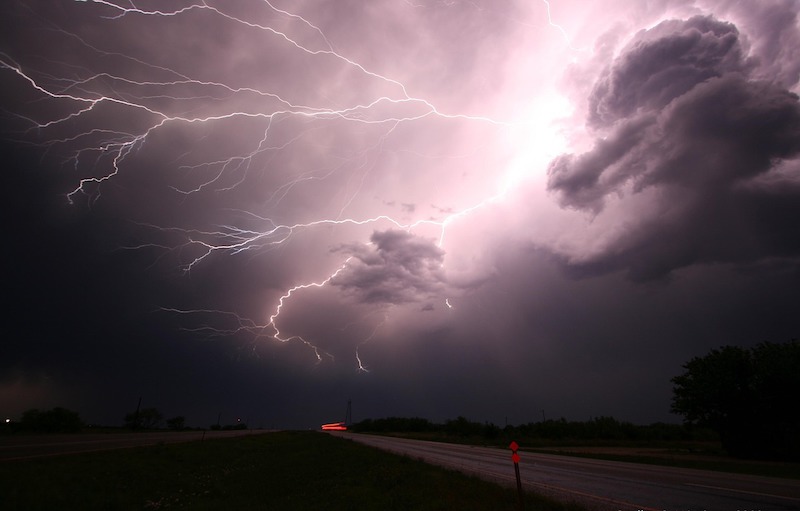Most people don't even consider that lightning could be a threat to their beautiful trees. Read this post to find out how to revive and restore your tree after a lightning strike.
Lightning Strikes
Q: I have a tulip tree that was here when we bought the house in 1984. It was thriving until last year. It was in full bloom with very large flowers and leaves when, all of a sudden, the bark started to peel off in large pieces and the branches started dying and dropping. At this time, only two or three branches have leaves.
There are some new suckers that are about 10 feet high. What could have caused the tree to start dying so fast? How long does a tulip tree live? Will the suckers grow into a decent-sized tree?
A: The most likely cause of your tree's problems is that it was struck by lightning. It may have struck unexpectedly, and you may not have been home to hear it. There is nothing you can do for the tree now. But if a person has a tree that is susceptible to lightning strikes, he or she can prepare the tree.
We all know that lightning tends to strike the tallest object in an area and that trees are especially prone to being hit. Lightning's electrical charge can move up from the ground, and jump from tree to tree and into buildings. The installation of lightning rods and grounding rods protects not only the trees but also the houses and electrical equipment underneath them. Our electronic appliances run on about 120 volts of electricity, but lightning can be over 100 million volts. It can ruin computers, TVs, microwaves and lots of other modern machines.
Sometimes when lightning strikes a tree, it just runs down the rainwater on the outside of the bark and into the ground, causing little harm to the tree. Sometimes it runs down the sap on the inside of the bark. When it does this, it turns the sap into steam and the whole tree explodes like one giant kernel of popcorn. What a noise that makes! Most trees are in between these extremes. The strike usually causes a long crack an inch or two wide straight down, and other times it spirals down the side of the tree. Patches of bark blown are often off. If the tree is still alive and green a few weeks later, that is a good sign.
The roots in the area where the electrical charge hits the ground may have been killed, so they will have to grow back. The opposite is also true: The branches may have been damaged by the electrical shock. The roots need nourishment from the leaves, so with fewer leaves, it will take awhile before enough food can replenish them.
Even if both the top and the roots are fine, the tree can die if the trunk is damaged. Sometimes trees that are pretty much dead still have enough nutrients and water in the trunk to last for a few months, but they amount to nothing more than a flower sitting in a vase of water — being pretty for a while but already dead.
In instances of partial damage, you need to try to keep the tree from other types of stress. If your area is in a drought, then make sure it gets enough water without drowning the remaining roots. Fertilization and pest control will be items to watch. Very small amounts of fertilizer will be good, but be careful to not exceed the recommended rates, because burning the roots with fertilizer is much more harmful than underfertilizing.
The suckers that are sprouting up from the roots of the old tree can be used to grow a new tree or two. The roots may not have been as damaged as the top of the tree. They are trying to send up a new top and it has the potential to be a very fast-growing top if there are a lot of roots left. Tulip trees can grow fast when they're young, and they can live over a hundred years, so a new top could be a good replacement.
Choose a sucker that will not have growth problems when the original trunk is cut down, one that is straight and away from the house. It may be possible to keep more than one sucker if they are far enough apart do not interfere with one another.
A lightning protection system can be installed by a professional arborist. It is not an easy job. Lightning rod tips are installed on the highest-growing branches and the branches farthest out, so they must be moved farther up and out as the tree grows larger. Conducting wires connect the various tips to larger and larger wires down the trunk. Large trees require more than one cable going down. At the base of the tree, the cable is buried in the ground all the way out as far as the end of the branches. A grounding rod is then driven down into the ground.
If you have trees hanging over the house, you should consider this system installed. Trees in parks and on golf courses should also be considered.
Save or share this infographic for reference: Lightning Strikes

Email questions to Jeff Rugg at [email protected]. To find out more about Jeff Rugg and read features by other Creators Syndicate writers and cartoonists, visit the Creators Syndicate website at www.creators.com.
COPYRIGHT 2017 JEFF RUGG
DISTRIBUTED BY CREATORS.COM



